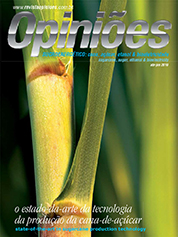Marcos Cesar Gonçalves
Scientific Researcher - Virologist at Instituto Biológico
Op-AA-24
Viroses: a real threat
Sugarcane is affected by more than 200 diseases, caused by fungi, bacteria, viruses, phytoplasms and nematodes, as reported in several countries. Diseases caused by viruses account for major shortfalls in plantation output, mainly due to reductions in plant saccharose content. The sugarcane mosaic was among the first diseases reported to have reached epidemic proportions in crops, at the beginning of the 19th Century.
Its viral nature was only subsequently discovered. A more recent example of a viral epidemics, in the 1990’s, sugarcane yellowing, brought about the replacement of one of the most productive varieties at that time in Brazil, while nevertheless concurrently having fostered scientific research to unravel the viral etiology of what was then referred to as the sugarcane yellow leaf syndrome.
One cannot deny the importance of quarantine diseases in Brazil, such as the Fiji disease virus, along with emerging ones deemed to likely be of viral eti-ology, which need to be monitored to prevent their entrance and dissemination in the country. Many viruses may inadvertently be introduced in new regions, due to latent infections, requiring special care concerning the exchange of germplasma, sometimes contaminated. Below is a brief analysis of the main sugarcane viruses and their distribution.
Mosaic virus: The sugarcane mosaic disease, caused in Brazil by the sugarcane mosaic virus (SCMV), is found in all sugarcane producing countries. Production loss estimates vary greatly, depending on the period considered and the planted area, and can reach large proportions. Historically, it has been the main viral etiology disease in Brazil. Nowadays, the disease is mostly under control in the country, however, one often finds symptomatic plants when assessing new cane clones in different phases of breeding programs and occasionally in nurseries and commercial plantations.
The recent increase in areas planted with corn, which also hosts the virus, in combination with the corn post-harvest, has resulted in the overlapping of plantation cycles and therefore, in more exposure to the main virus vector that colonizes corn. Such facts have contributed to a broader dissemination and occurrence of the mosaic and maintenance of the source of inoculum. As a consequence, more aggressive new virus strains are being disseminated with mosaic remaining potentially as one of the most important diseases in sugarcane crop.
Yellow leaf virus: The sugarcane yellow leaf syndrome (SYLS), popularly referred to in Brazil as amarelinho (little yellow one), became a problem in sugarcane plantations in the beginning of the 1990’s, in Brazil and the USA. Subsequently, the disease was reported in most grower countries, bringing about significant decline in the performance of important cultivars. In Brazil, the variety SP71-6163, highly productive and one of the most planted until the disease appearance, was the first to show symptoms, reaching production losses up to 50% with epidemic proportions in the State of São Paulo. The causal agent is the sugarcane yellow leaf virus (SCYLV), a recombinant virus in the family Luteoviridae. Recently, in Cuba, the Saccharosydne saccharivora hopper was described as the vector of sugarcane yellow leaf phytoplasm, the putative responsible for one of the forms of SYLS. S. saccharivora is only found in Central America, the Caribe and India, which explains its restricted occurrence in some regions of the globe.
Quarantine Diseases: One needs to be aware of a potential threat to sugarcane plantations in Brazil: the Fiji disease virus (FDV), genus Fijivirus, family Reoviridae.
The FDV is reported in several sugarcane producing regions around the globe, in Asia, Africa and Oceania, and it is one of the most important sugarcane viral diseases in Australia and South Pacific islands. Epidemics caused by the disease took place in Australia in the 1970’s and 1980’s, causing sugarcane plant losses of 50% and of 100% in the case of sugarcane ratoons. FDV and its main vector, Perkinsiella saccharicida, are deemed to be quarantine diseases in Brazil. There is a high risk the disease may be introduced and disseminated in the country, given that the vector hopper has been reported to exist in Colombia and Ecuador.
Control and handling of varieties: The main measure of controlling viruses consists of selecting and employing resistant varieties, in combination with roguing, especially in the case of the mosaic, in seed-ling nurseries. Breeding programs assess differences in variety behavior in terms of resistance to the main viruses. Such information must be taken into account when selecting varieties for planting, according to the region’s historical record. One must use healthy plantlets for planting, because apart from vegetative propagation, vectors of the main viruses are in our fields and can disseminate the pathogens in susceptible cultivar, gradually increasing the infection percentage in ratoons. Therefore, the tissue culture is highly recommended for seedling propagation and may be useful in controlling viruses as well as other sugarcane pathogens.
The use of genetic engineering, allowing for the introduction of transgenes derived from the pathogen,providing resistance to elite clones, constitutes a promising and alternative way to improve the conventional breeding for viruses’ resistance in a short period. Successful research has been conducted in this area, and the findings will be applicable in the near future. How-ever, there are still obstacles in terms of legislation and approvals for field testing and the commercial planting of transgenic sugarcane.




